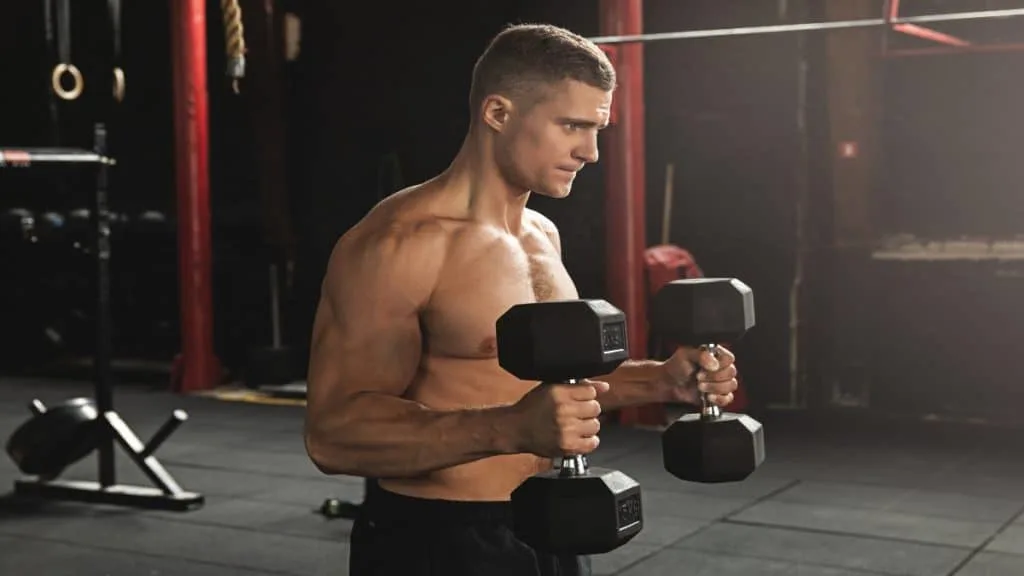Is curling 25 lbs for reps an effective way to build your biceps? Also, how much can the average man dumbbell curl?
If you’ve ever wondered about either of these questions, then this article is for you. We explain how a 25 lb bicep curl is actually a lot more effective for building mass than most bodybuilders would have you believe.
The biceps musculature, after all, is a small body part that doesn’t need to lift the heaviest weights in the gym to grow to a good size.
More Bicep Curl Guides:
Is curling 25 lbs good for building muscle?

Is curling 25 lbs for reps a good way to build and strengthen your biceps?
Yes, performing 25 lb dumbbell curls with strict form for multiple reps and sets is a very effective way to build the muscles in your biceps.
This is because your biceps respond—by growing bigger and stronger—to the tension that you put them under. [1] So even though a 25 lb bicep curl might not seem like much resistance, that amount of weight can actually challenge your biceps a lot if you know how to lift with the proper bicep-building technique.
Obviously, doing just a few reps with 25 pounds isn’t going to cut it because your biceps won’t be under tension for long enough to get a good workout.
On the other hand, if you’re doing multiple sets of 10-15 reps, then you can definitely see some good gains from curling 25 pounds. Likewise, if you can curl 25 pounds for 10 reps today and 20 reps in a few months (at the same relative intensity), [2] then your biceps will likely have gained some size.
Why am I stuck on 25 lb dumbbell curls?

If you’re stuck on 25 pound dumbbell curls or a similar resistance level, then it might be because 25 lbs is already a good weight for someone with your genetics to be lifting.
While a professional bodybuilder may no longer see results from doing 25 pound arm curls, that’s not to say that novice and intermediate lifters can’t build their biceps with 25 lbs. If you’re using strict muscle-building form, then 25 lbs can actually feel quite challenging when you train close to failure.
After all, your muscles don’t know how much weight you’re lifting, and the biceps tend to respond exceptionally well to high reps.
So if you’re struggling to progress beyond 25 lb curls, try and do more reps per set before graduating to a heavier pair of dumbbells. Once you can do multiple sets of 10-15 reps, then you could try lifting the 30 pounders for a few reps to improve your strength.
Related: Is curling 30 lbs good?
25 lb dumbbell curl case studies
These interesting case studies show you what kind of results and workouts you can get from doing 25 pound curls.
Case study 1: Jenny
A woman called Jenny appeared on the YouTube channel Freddie’s Modern Kung Fu and did 25 lb dumbbell curls for 6 reps per arm.
Now, if you’re a guy who only lifts 25 lbs, then don’t think that you need to increase the resistance just because a woman can lift the same amount of weight as you!
Although 6 reps per arm is impressive, it’s obviously more impressive to do sets of 20 reps with cleaner form.
Jenny’s technique was good, and she clearly used her biceps to do the majority of the lifting. However, if she reduced her shoulder movement, then her biceps would get an even better workout without her lifting any more weight.
So improving your technique is often better, in terms of biceps stimulation, than increasing the resistance. This is because, as mentioned earlier, your biceps just respond to the tension that you put them under.
Case study 2: Chris Andersen
Chris Andersen has an excellent physique and can probably curl a lot more than 25 pounds. However, in his video, you could clearly see that his biceps were being highly activated with nothing other than a pair of 25 lb dumbbells.
As people noted in the comments, curling 25 lbs can produce results as long as you do enough reps and sets. A good benchmark in this regard is 3 sets of 20 reps.
Once you become reasonably strong, 25 lbs will feel like a pump weight. That is, 25 lbs will become a weight that you’d use to get a pump by performing high reps.
It’s great to be able to rep out a weight (25 lbs) for sets of 20 when previously you could only curl it for a few hard-earned reps.
Case study 3: David Craig
One look at David Craig’s bulging biceps, and you’d think that 25 lb dumbbells would be too light for him.
However, his video just goes to show that form is often much more important than weight when it comes to hypertrophy.
No, he’s not setting any records. But he’s giving his biceps a phenomenal workout by using strict mass-building technique and doing plenty of training volume.
His case study also proves that you can build your biceps with minimal equipment. There’s no need to go to the gym and perform an elaborate routine when you can create the same amount of tension within your biceps—and save time in the process—by using 25 lb dumbbells.
The verdict: Who should be doing 25 pound bicep curls?

If you’ve been training seriously for less than a year (less than 6 months is even better) and can do 25 pound bicep curls for multiple sets of 15-20 reps, then that’s very good. If your form is strict, then it’s highly likely that you’ll have some well-developed biceps to show for your efforts.
When it comes to curling 25 lbs, the gold standard is to work your way up to 3 sets of 30 reps. Contrary to popular belief, high reps, if they’re performed close enough to muscular failure, can work wonders for your biceps development.
So don’t think that you need to increase the resistance and curl more than 25 lbs if you want to grow your arms. As you know, implementing progressive tension (by improving your form and/or doing more reps and sets) is often more effective for simulating hypertrophy than upping the weight.
References
- Burd, N. A., Andrews, R. J., West, D. W., Little, J. P., Cochran, A. J., Hector, A. J., Cashaback, J. G., Gibala, M. J., Potvin, J. R., Baker, S. K., & Phillips, S. M. (2012). Muscle time under tension during resistance exercise stimulates differential muscle protein sub-fractional synthetic responses in men. The Journal of Physiology, 590(2), 351–362. https://doi.org/10.1113/jphysiol.2011.221200
- Munoz, J. (2017, August 21). Design Effective Training Programs Using Relative Intensity. Biolayne.Com. https://www.biolayne.com/articles/training/design-effective-training-programs-using-relative-intensity/

